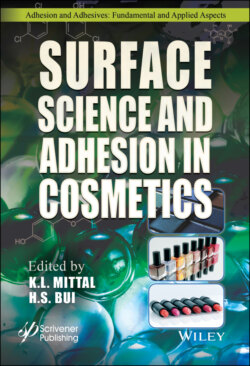Читать книгу Surface Science and Adhesion in Cosmetics - Группа авторов - Страница 73
3.5.3 Methods for Mitigating Oxygen Inhibition During UV Cure
ОглавлениеNumerous techniques have been used to mitigate oxygen inhibition. As shown in Table 3.1 these oxygen mitigation techniques offer several methods that work only to a certain degree [6].
Figure 3.11 Chain termination of the free radical initiator (see PI in Figure 3.2.) by oxygen. When the free radical is formed, oxygen in the environment quenches the PI to an unexcited non-reactive state. This quenching lowers the number of polymeric chains and cross-linking within the system. As can be seen in the first step the reaction forms an oxygen based free radical which then seeks another free radical and then chain terminates as shown in the second step. This classically results in the formation of an uncured surface.
Table 3.1 Methods to Mitigate Oxygen Inhibition showing Advantages and Disadvantages. These techniques can include, but are not limited to, the following methods: uses of inert gases, waxes, coatings, increased PI concentration, increased light intensity and use of thiols, amines and ethers.
| Method | Advantages | Disadvantages |
| Inert Gas | Does not adversely affect coating properties | Expensive; difficult to implement |
| Waxes | Inexpensive | Affects final coating properties; time needed for migration |
| Films | Good solution when film becomes part of product | Cost/disposal of film when not part of product |
| Increased PI Concentration | Easy to implement | Increased residuals/ by-products; reduced coating properties |
| Increased Light Intensity | May not affect coating properties | Part of existing equipment; cost |
| Thiols | Improved thermal resistance; reduced moisture absorption; improved adhesion | Odor |
| Amines | Inexpensive; possible improved adhesion | Yellowing upon or after cure; residual odor; moisture sensitivity |
| Ethers | Can be used in large quantities | Affects coating properties; reduced temperature resistance; possible reduced water resistance |
Inert gases work quite well since the coating is in absence of oxygen so no oxygen inhibition can occur. In fact, electron beam curing will only work when done in an inert atmosphere. Paraffinic waxes work well also but complicate the issue with gloss since paraffinic waxes migrate to the surface and are low gloss. Two additional steps are needed to bring the UV cured coating back to its original gloss by first grinding away the wax and then buffing and polishing the surface back to a high gloss. Barrier coatings work but again add an additional step in the process and are problematic on contoured surfaces. Increasing the PI concentration is also an easy fix but it is costly and can reduce the coating properties. Also increasing the UV light intensity can help override the oxygen inhibition issues but could result in coating degradation. Thiolene based acrylate (mercapto acrylate) is currently being used in the UV cure industry but results in ‘post odor’ of the UV cured coating. Amines are also used but result in yellowing and ‘post odor’ of the UV cured coating. Ether acrylate-based chemistries are used but might result in poor performance properties of the cured coating.
